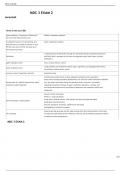8/8/24, 2:28 AM
MDC 3 EXAM 2
Jeremiah
Terms in this set (100)
hyperventilation, if someone is blowing off Alkaline, respiratory alkalosis
too much CO2 they become more
if a patient's lung are not functioning very acidic, respiratory acidosis
well and they are unable to remove or blow
off CO2 very well, the CO2 will build up in
their system becoming
is adequate arterial blood flow through the peripheral tissues (peripheral perfusion)
Perfusion and blood that is pumped by the heart to oxygenate major body organs (central
perfusion)
upper respiratory tract nose, sinuses, pharynx, larynx
Lungs,Trachea, two mainstem bronchi, lobar, segmental, and subsegmental bronchi;
Lower respiratory tract
bronchioles; alveolar ducts; alveoli
common cause of respiratory ailments Cigarette smoke
maintaining a patent airway to allow adequate ventilation and oxygenation.
Along with a focused respiratory assessment, the nurse will utilize information obtained
Nursing care of a patient experiencing upper from the patient and family during the admission history interview. Information
respiratory system disorders regarding the patient's history of upper respiratory disorders, smoking, and
environmental exposures will be utilized to determine the necessary testing and
treatment
Alveoli function decreases
Ability to cough decreases
Lungs loose residual volume, vital capacity and gas exchange decreases.
Normal Changes in Aging Adults
Respiratory muscles atrophy
Vascular resistance increases, capillary flow decreases
Susceptibility to infection increases.
three bones that protrude into the nasal cavities from the internal portion of the nose
The turbinates increase the total surface area for filtering, warming, and humidifying inspired air before
it passes into the nasopharynx.
MDC 3 EXAM 2
1/25
,8/8/24, 2:28 AM
air-filled cavities within the bones that surround the nasal passages
The paranasal sinuses Lined with ciliated membrane, the sinuses provide resonance to speech, decrease the
weight of the skull, and act as shock absorbers in the event of facial trauma..
Fremitus refers to vibratory tremors that can compression or consolidation of lung tissue, as occurs in pneumonia.
be felt through the chest by palpation,
Increased fremitus may indicate
Bronchial
Lung sounds Bronchovesicular
Vesicular
Crackles
Wheezes
Adventitious sounds
Rhonchus
Pleural friction rub
Cyanosis, decreased capillary refill, clubbing of nails in fingers, level of consciousness,
Other Indicators of Respiratory Adequacy
Chest Circumference, Anxiety, Dyspnea Orthopnea, General Appearance
Laboratory assessment
- RBC
- ABG- is a blood gas and this tells us the acid base balance of the patient
- Sputum- can tell us if microorganisms are growing in the lung - describe color, clarity,
and any odor
Imaging assessment
- x-rays-Xrays show us areas of opaque which usually indicate
pneumonia/consolidation of fluid
Diagnostic Assessment of lungs -CT- computed tomography. Lung nodules, areas of fluid buildup
Other noninvasive diagnostic assessments
- Pulse oximetry-circulating O2- tells us oxygen levels in the tissues- usually fingers,
toes, or earlobes
- Capnometry and capnography-how much CO2 is leaving the lungs.
-PFTs-Lung function- tell us how well the lungs function at moving air in and out
- Exercise testing-Exercise tolerance
-Endoscopic examinations
-Bronchoscopy- is a camera that looks at the airway passages
Invasive Diagnostic Assessment
-Thoracentesis- can remove fluid buildup from the lung
-Lung biopsy- is used to diagnose some lung diseases or cancer
A.Tightening of the vocal cords
B.Decrease in residual volume
C.Decrease in the anteroposterior diameter
Which assessment finding for an older adult
D.Decrease in respiratory muscle strength
patient does the nurse ascribe to the natural
aging process?
D. As a person ages, vocal cords become slack, changing the quality and strength of
the voice; the anteroposterior diameter increases; respiratory muscle strength
decreases; and the residual volume increases.
MDC 3 EXAM 2
2/25
, 8/8/24, 2:28 AM
A.25%
B.50%
C.75%
D.100%
The nurse knows that under normal
physiologic conditions of tissue perfusion, a
ANS: B
patient will have what percent of oxygen
Oxygen dissociates with the hemoglobin molecule based on the need for oxygen to
dissociate from the hemoglobin molecule?
perfuse tissues. Under normal conditions, 50% of hemoglobin molecules completely
dissociate their oxygen molecules when blood perfuses tissues that have an oxygen
tension (concentration) of 26 mm Hg. This is considered a "normal" point at which 50%
of hemoglobin molecules are no longer saturated with oxygen.
A.Cough
B.Dyspnea
C.Chest pain
D.Sputum production
Which assessment finding does the nurse
ANS: A
interpret that is associated most closely with
lung disease?
Cough is a main sign of lung disease. Dyspnea (difficulty in breathing or breathlessness)
is a subjective perception and varies among patients. A patient's feeling of dyspnea may
not be consistent with the severity of the presenting problem. Sputum production may
be associated with coughing and indicate an acute or chronic lung condition. Chest
pain can occur with other health problems, as well as with lung problems.
Squamous cell carcinoma and slow growing
Begins with mucus that is chronically irritated, becoming tougher and thicker
Head and Neck Cancer
Leukoplakia and erythroplakia lesions
Spreads to local lymph nodes, muscle and bone, then to liver or lungs.
• Tobacco use
• Alcohol use
• Voice abuse
• Chronic laryngitis
Risks of head and neck cancer
• Exposure to chemicals
• Poor hygiene
• Long-term gastroesophageal reflux disease
• Oral infections with human papillomavirus
Lumps in mouth, throat, neck
Difficulty swallowing
Color changes in mouth or tongue
Oral lesion or sore that does not heal in 2 weeks
Persistent, unilateral ear pain
Persistent/unexplained oral bleeding
Assessment: Noticing- head and neck Numbness of mouth, lips, or face
cancer Change in fit of dentures
Hoarseness or change in voice quality
Persistent/recurrent sore throat
Shortness of breath
Anorexia and weight loss
Change in fit of dentures
Burning sensation when drinking citrus or hot liquids
Potential for airway obstruction
The priority interprofessional collaborative
Potential for aspiration
problems for patients with head and neck
Anxiety
cancer include
MDC 3 EXAM 2 Decreased self esteem
3/25




